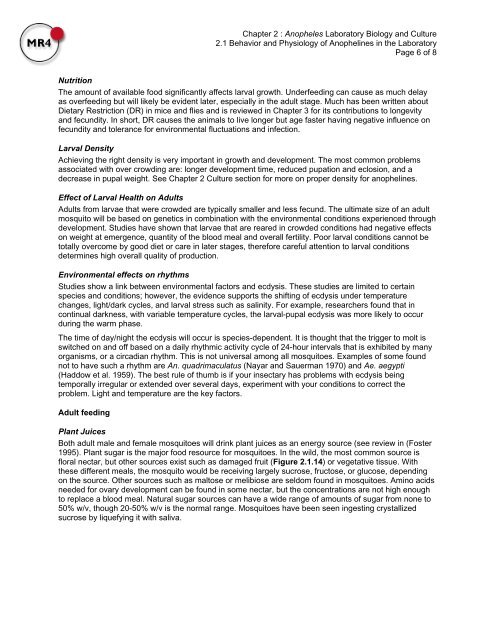Methods in Anopheles Research - MR4
Methods in Anopheles Research - MR4
Methods in Anopheles Research - MR4
- No tags were found...
Create successful ePaper yourself
Turn your PDF publications into a flip-book with our unique Google optimized e-Paper software.
Chapter 2 : <strong>Anopheles</strong> Laboratory Biology and Culture2.1 Behavior and Physiology of Anophel<strong>in</strong>es <strong>in</strong> the LaboratoryPage 6 of 8NutritionThe amount of available food significantly affects larval growth. Underfeed<strong>in</strong>g can cause as much delayas overfeed<strong>in</strong>g but will likely be evident later, especially <strong>in</strong> the adult stage. Much has been written aboutDietary Restriction (DR) <strong>in</strong> mice and flies and is reviewed <strong>in</strong> Chapter 3 for its contributions to longevityand fecundity. In short, DR causes the animals to live longer but age faster hav<strong>in</strong>g negative <strong>in</strong>fluence onfecundity and tolerance for environmental fluctuations and <strong>in</strong>fection.Larval DensityAchiev<strong>in</strong>g the right density is very important <strong>in</strong> growth and development. The most common problemsassociated with over crowd<strong>in</strong>g are: longer development time, reduced pupation and eclosion, and adecrease <strong>in</strong> pupal weight. See Chapter 2 Culture section for more on proper density for anophel<strong>in</strong>es.Effect of Larval Health on AdultsAdults from larvae that were crowded are typically smaller and less fecund. The ultimate size of an adultmosquito will be based on genetics <strong>in</strong> comb<strong>in</strong>ation with the environmental conditions experienced throughdevelopment. Studies have shown that larvae that are reared <strong>in</strong> crowded conditions had negative effectson weight at emergence, quantity of the blood meal and overall fertility. Poor larval conditions cannot betotally overcome by good diet or care <strong>in</strong> later stages, therefore careful attention to larval conditionsdeterm<strong>in</strong>es high overall quality of production.Environmental effects on rhythmsStudies show a l<strong>in</strong>k between environmental factors and ecdysis. These studies are limited to certa<strong>in</strong>species and conditions; however, the evidence supports the shift<strong>in</strong>g of ecdysis under temperaturechanges, light/dark cycles, and larval stress such as sal<strong>in</strong>ity. For example, researchers found that <strong>in</strong>cont<strong>in</strong>ual darkness, with variable temperature cycles, the larval-pupal ecdysis was more likely to occurdur<strong>in</strong>g the warm phase.The time of day/night the ecdysis will occur is species-dependent. It is thought that the trigger to molt isswitched on and off based on a daily rhythmic activity cycle of 24-hour <strong>in</strong>tervals that is exhibited by manyorganisms, or a circadian rhythm. This is not universal among all mosquitoes. Examples of some foundnot to have such a rhythm are An. quadrimaculatus (Nayar and Sauerman 1970) and Ae. aegypti(Haddow et al. 1959). The best rule of thumb is if your <strong>in</strong>sectary has problems with ecdysis be<strong>in</strong>gtemporally irregular or extended over several days, experiment with your conditions to correct theproblem. Light and temperature are the key factors.Adult feed<strong>in</strong>gPlant JuicesBoth adult male and female mosquitoes will dr<strong>in</strong>k plant juices as an energy source (see review <strong>in</strong> (Foster1995). Plant sugar is the major food resource for mosquitoes. In the wild, the most common source isfloral nectar, but other sources exist such as damaged fruit (Figure 2.1.14) or vegetative tissue. Withthese different meals, the mosquito would be receiv<strong>in</strong>g largely sucrose, fructose, or glucose, depend<strong>in</strong>gon the source. Other sources such as maltose or melibiose are seldom found <strong>in</strong> mosquitoes. Am<strong>in</strong>o acidsneeded for ovary development can be found <strong>in</strong> some nectar, but the concentrations are not high enoughto replace a blood meal. Natural sugar sources can have a wide range of amounts of sugar from none to50% w/v, though 20-50% w/v is the normal range. Mosquitoes have been seen <strong>in</strong>gest<strong>in</strong>g crystallizedsucrose by liquefy<strong>in</strong>g it with saliva.
















